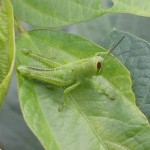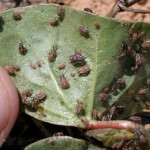Threecornered alfalfa hoppers (TCAH) are being reported in soybean fields scattered throughout West Tennessee. In my experience, populations during the seedling stage are often highest in late planted, reduced tillage fields (often in wheat beans). In soybean less than 8-10 inches tall, this insect feeds in a circular fashion around the plant stem with its beak. This girdling will eventually cause a swollen callus on the stem, but this may not be obvious on small plants. Girdling causes little damage unless plants break over. Continue reading
All posts by Scott Stewart, West TN Research & Education Center

Grasshoppers in Soybean
 Based on some phone calls, grasshoppers are causing some serious injury to seedling soybean in some localized areas. This is not uncommon, especially in reduced tillage fields and also tends to be worse following a previously dry year. Treatment should be made if Continue reading
Based on some phone calls, grasshoppers are causing some serious injury to seedling soybean in some localized areas. This is not uncommon, especially in reduced tillage fields and also tends to be worse following a previously dry year. Treatment should be made if Continue reading
Cotton Irrigation
Ask 10 different people how to effectively use over-head (center pivot) irrigation and you will get 10 different responses. Driving around west Tennessee it becomes apparent that substantial investments have been made to increase irrigation capacity over the last two years.
Continue reading
Japanese Beetles in Corn, Soybean and Cotton
Japanese beetles are showing up in corn, soybean and cotton. Of these cotton is their least favorite. These showy beetles often hang out in groups and draw a lot of attention. Fortunately, they rarely cause yield loss in field crops. The beetles will feed on leaves, flowers and corn silks. Japanese beetles have a wide host range which includes many ornamental plants. They were introduced into the northeast U.S. nearly 100 years ago and have been slowly spreading south and east ever since. They only have one generation per year, and the adults started emerging last week. Adults will continue to emerge for several more weeks and will persist into July. Larvae are white grubs that feed underground and are sometimes a pest of turfgrass. Continue reading
Treatment Recommendations for Plant Bugs
I’ve had some reports of well-above treatment levels of tarnished plant bugs in cotton that is just beginning to square. Be advised that plant bugs will often concentrate in the first fields that begin squaring. There have also been reports of brown and green stink bug Continue reading
Thrips Now, What’s Next?
THRIPS continue to plague some cotton, and treatments are still being made and needed on some cotton that is fourth and fifth leaf. Clearly much of this is due to high pressure and poor weather conditions during emergence nearly a month ago. Not making timely treatments at the first and second leaf cotton has also resulted in a later than normal need for foliar thrips application. Much of this was to be expected given the tight schedule that growers were on in planting and replanting. However, there has also been some control “failures” of insecticide seed treatments. In these examples, two or even three applications for thrips have been justified. Most complaints have been on cotton planted May 5-15 and where Cruiser was used. Phytogen 375 WRF was another commonality, but this is not too surprising considering how much of our acreage is planted with this variety. Continue reading

False Chinch Bugs in Cotton and Soybean
 Beginning Friday and continuing over the weekend I received a few calls about false chinch bug infestations in cotton and soybeans. This is an occasional but potentially serious pest of these crops during the seedling stages. They are most often associated with reduced tillage where delayed burndowns allowed certain weeds to persist into the field close to or after planting. My colleague, Angus Catchot, just posted an article about this pest on The MSU Crop Blog site at Continue reading
Beginning Friday and continuing over the weekend I received a few calls about false chinch bug infestations in cotton and soybeans. This is an occasional but potentially serious pest of these crops during the seedling stages. They are most often associated with reduced tillage where delayed burndowns allowed certain weeds to persist into the field close to or after planting. My colleague, Angus Catchot, just posted an article about this pest on The MSU Crop Blog site at Continue reading
What is wrong with my cotton?
Take your pick; water logged soils, crusted soils, rotted seed, herbicide damage (see Dr. Steckel’s comments in this Blog), Rhizoctonia, Black Root Rot, Pythium, or Ascochyta (wet weather blight). Some, all, or any combination of these have lead to lots of replant calls and visits this week. The good news is that we should know what damage has been done by this weekend. Warm temperatures have Continue reading
